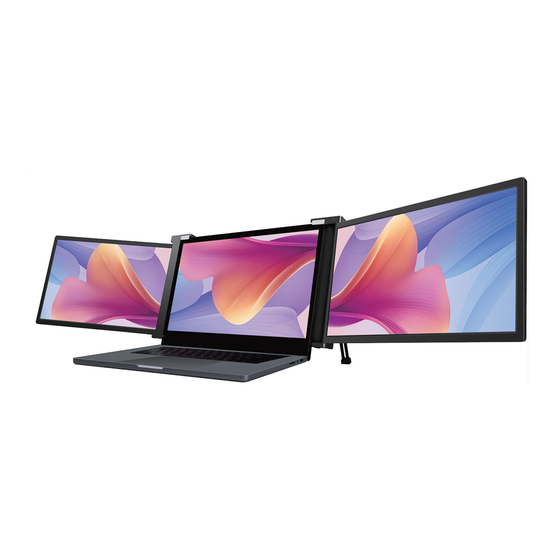
Advertisement
Table of Contents
Advertisement
Table of Contents

Summary of Contents for Kogan KAMN133TFDEA
- Page 1 FHD PRO DUAL SCREEN TRI- FOLD PORTABLE MONITOR 13.3" KAMN133TFDEA...
-
Page 3: Safety And Warnings
SAFETY & WARNINGS • Handle the tri-screen with care and do not press the screens to avoid damage. • Do not exceed its maximum turning angle showing as below: Turning angle of screens Left screen (0° - 235°) Right screen (0° - 180°) - Page 4 COMPONENTS Monitor USB-C - USB-C (90-degree) Cables (x2) Mini HDMI - HDMI Cables (x2) USB-C - USB-A Cables (x2) Carry Bag Velcro Fastener Protective Caps (x6)
-
Page 5: Operation
OPERATION Inputs and Buttons Press the Menu to enter the OSD (On-Screen Display) menu. Increase the brightness, enter menu and press it to turn to the next selection, increase the value Decrease the brightness, return to the previous page, decrease the value x2 USB-C Ports: fully functional, power supply, video signal transmission... - Page 6 Selecting the Right Cables • To determine which cables you will use, first identify your laptop’s ports using the pictures below or reference your laptop’s user manual. • If your laptop has two Thunderbolt3/4 / USB-C with DP ports, the simplest way to use the tri-screen is with the two USB-C to USB-C cables provided.
- Page 7 Protective Caps Using the protective cap if your laptop is an ultra-thin style (laptop screen thickness ≤6mm), this helps keep your laptop in place.
-
Page 8: Installation
INSTALLATION Unpack the monitor. Open the two screens in the direction shown. Place the bracket at the back of the laptop screen and install it well with the bracket clamping the screen. Lift up the stand and stretch to its end. Press and hold the button to retract the stand. (The stand is embedded in the rear of the triple monitor, which can offer extra support to the monitor.) Using the necessary cables, plug one end of the cable into the triple monitor and the... - Page 9 CONNECTIVITY Two USB-C or Thunderbolt 3/4 Ports If there are 2 full-functioned USB-C or 2 Thunderbolt 3/4 ports on the laptop, use the 2 included USB-C cables to connect the laptop to the monitors. USB-C USB-C USB-C Note: Ensure that the laptop USB-C ports support power & data transmission and has enough power supply above 5V/2A.
- Page 10 One Full Functioned USB-C and HDMI Port Connection If there's one full functioned USB-C port and one HDMI port on the laptop: Use the included full functioned USB-C cable to connect one side of the monitor and the laptop. Meanwhile, use the HDMI cable and an extra power supply (USB-C to USB-A cord) to connect the other side of the monitor and the laptop.
- Page 11 Laptop Display Configuration PC / WINDOWS Go to your Display Settings (Start > Settings > System > Display) Click and drag screens to configuration shown If you need to set different display modes for multiple screens, please click 1/2/3 (click the "Identify"...
- Page 12 Open “System Preferences” Select “Displays” from the menu Click “Display Settings” from display menu. Click monitor name to set Mirror or Extended display. Click any display screen in the interface to adjust the screen position. To increase the zoom, click the “Scaled” radio button.
- Page 13 OSD (on screen display) Press the “ ” Menu button to activate the OSD menu. Press “+” button to choose your settings. Press Menu “ ” button to confirm. Press “-” button to return to previous page. OSD Settings Brightness: The adjusting range is from 0 to 100.
- Page 14 Colour Temp Colour Temp: Enables the adjustment of each individual RGB colour or select a Warm or Cool preset level Red: The adjusting range is from 0 to 100 Green: The adjusting range is from 0 to 100 Blue: The adjusting range is from 0 to 100 OSD Setting Language: Select OSD language.
-
Page 15: Specifications
SPECIFICATIONS Two 13.3inch (diagonal) 1920*1080, Full HD LCD IPS Panels 16:9 aspect ratio Display Adjustable brightness Power consumption: 5V 2A (Per screen) Thunderbolt 3/4 / USB-C 3.1 input Video and Power Thunderbolt 3/4 / USB-C 3.1 input Inputs and connectivity (per screen) Video and Power Mini-HDMI input Video Only... - Page 16 Need more information? We hope that this user guide has given you the assistance needed for a simple set-up. For the most up-to-date guide for your product, as well as any additional assistance you may require, head online to help.kogan.com...















Need help?
Do you have a question about the KAMN133TFDEA and is the answer not in the manual?
Questions and answers